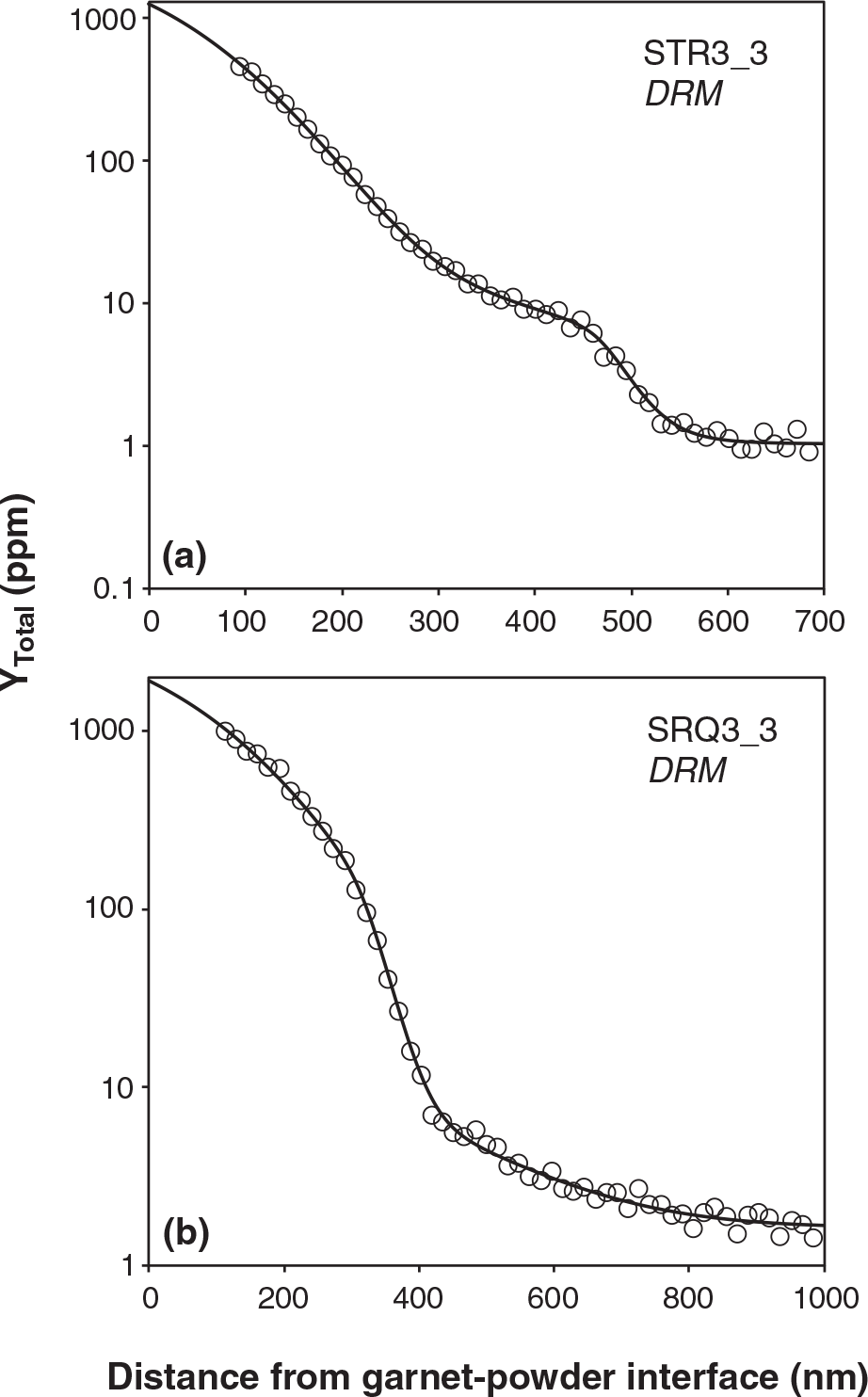Experimental Geochemistry
Multi-Species Diffusion Processes
In terms of incipient and future experimental research, much of my focus is on multi-species diffusion processes. Over the past several years, an increasing number of experimental studies using high-sensitivity analytical techniques, such as LA-ICP-MS or SIMS, have reported complex diffusion profiles that cannot be explained using traditional diffusion models (e.g., standard analytical diffusion equations, multicomponent diffusion models or concentration-dependent diffusion models). Instead, these profiles are well fit using multi-site or multi-species diffusion models, by which a diffusing species can occupy and diffuse through two or more sites within a crystal, which are related through exchange reactions. The recognition of multi-species diffusion processes is a potentially transformational development for applications of diffusion kinetics within Earth and planetary sciences. Because many geologically important minerals (both major rock-forming and accessory minerals) contain multiple crystallographic and/or interstitial sites that individual trace elements could distribute themselves over, it is conceivable that multi-species diffusion processes are considerably more prevalent than recognized thus far. Multi-species diffusion processes not only significantly change the diffusion coefficients that are retrieved from experimental studies, but also indicate that one must understand what mechanism is occurring in nature in order to correctly apply experimental data to model natural processes. Understanding multi-species diffusion, and determining how ubiquitous these processes are for diffusion in naturally occurring minerals, is therefore of paramount importance for many geochemical and geochronological studies.
From Bloch et al. (2020)
From Bloch et al. (2022)
Ti Diffusion in Zircon
Although Ti in zircon has become one of the most routinely used geothermometers for igneous systems, due in part to reports of extremely sluggish Ti diffusion in this mineral, previous studies have only measured Ti diffusion perpendicular to the crystallographic c-axis in this mineral. I recently conducted experiments between 1540 – 1100 °C, and in this temperature range found Ti-in-zircon diffusivities up to 5 orders of magnitude faster than the currently available published data indicate. The primary reason for this large difference is that Ti in zircon exhibits a high degree diffusion anisotropy, with diffusion parallel to the crystallographic c-axis occurring much more rapidly than diffusion perpendicular to the c-axis. If these data are extrapolated to typical temperatures of interest for igneous zircon crystallization (~600-950 °C), then Ti diffusion in zircon is ~8-11 orders of magnitude faster than previous studies indicate. This large difference in diffusivities clearly indicates that the potential for volume diffusion to modify Ti concentrations in zircon under crustal conditions needs to be re-evaluated. As part of this study (Bloch et al., 2022), we developed 2D and 3D numerical models (example below) to simulate Ti diffusion in zircon, which are available here. I am currently analysing a variety of natural zircons, in which diffusion profiles of Ti are being measured via both SIMS and LA-ICP-MS, in order to further evaluate in what natural settings and to what extent Ti concentrations in zircon are compromised by volume diffusion. I am also in the early stages of an experimental study looking at the diffusion kinetics of U, Th, Hf and Zr parallel to the c-axis in zircon.
Garnet Geochronology/Diffusion Chronometry
A significant component of my experimental work has been aimed at determining the diffusion kinetic properties of Lu and Hf in garnet. This research was motivated by the observation that Lu-Hf and Sm-Nd garnet dates from the same samples are commonly not in agreement with one another, as noted in dozens of publications. We have found that Lu diffuses substantially faster than Hf in garnet; as a result, at realistic igneous and metamorphic temperatures there can be a diffusive flux of Lu into or out of garnet while Hf remains essentially immobilized, which leads to Lu-Hf ages being skewed in some natural samples (Bloch et al., 2015; Bloch and Ganguly, 2015). A follow-up study, in which the extent to which diffusant concentration and silica activity affect REE and Hf diffusion in garnet was quantified, was recently published (Bloch et al., 2020). This latter paper also presents a model for multi-site diffusion-reaction processes for Y and REEs in garnet, in which we demonstrated that the diffusivities of these species exhibit order-of-magnitude differences based on their concentration, site occupation and association with other ions.
The difference between Lu and Hf diffusivities in garnet, coupled with the observation that Nd isotopes appear susceptible to diffusive resetting via a low-concentration mechanism that allows faster diffusion than Hf or bulk Lu, explains the commonly observed dating discrepancies between these two geochronological systems. Although this research indicates that garnet Lu-Hf and Sm-Nd dating can sometimes be complex, particularly in high-temperature systems, these techniques can in fact constrain more complete thermal histories when carefully combined with thermobarometry and diffusion chronometry (see research on Lithospheric Processes for further detail).
More recently, Arnaud Devoir (a former Ph.D. student that I co-advised with Othmar Müntener at the University of Lausanne) has used these data to simultaneously model in-situ major-element multicomponent and trace element diffusion profiles in igneous garnets (Devoir et al., 2021). In addition to providing further evidence from natural samples that these experimental studies are representative of what occurs in nature, these models have provided tight constraints on the thermal history of migmatites from the Ivrea zone in the Italian Alps. Arnaud is now conducting postdoctoral research at UNIL with Othmar Müntener and myself, which is largely aimed at experimentally quantifying Li, Cr and P diffusion in almandine and spessartine.
From Bloch et al. (2020)
From Devoir et al. (2021)




